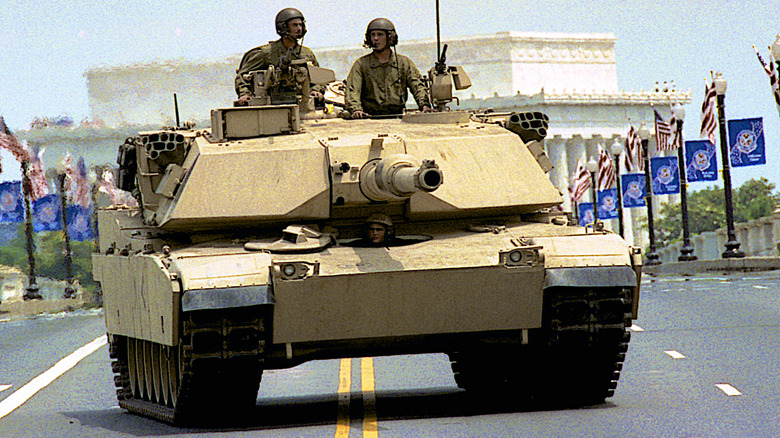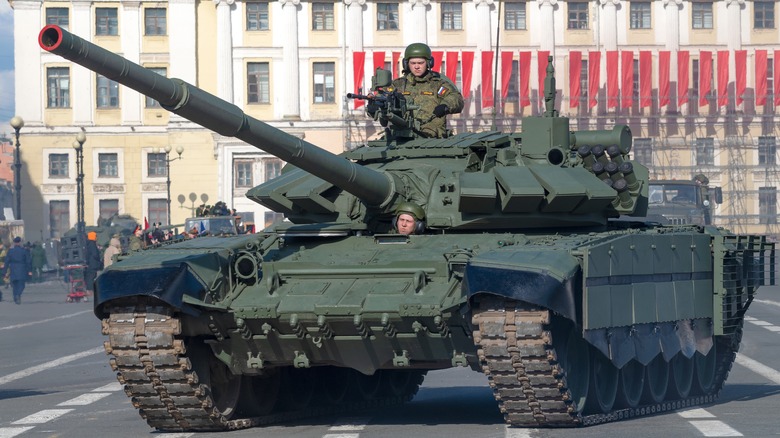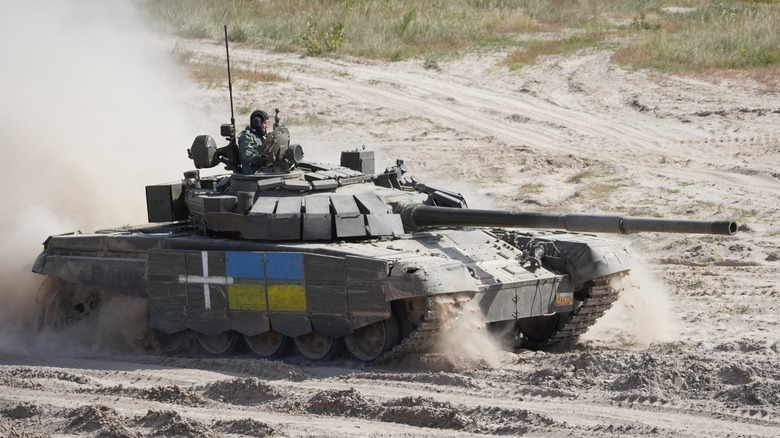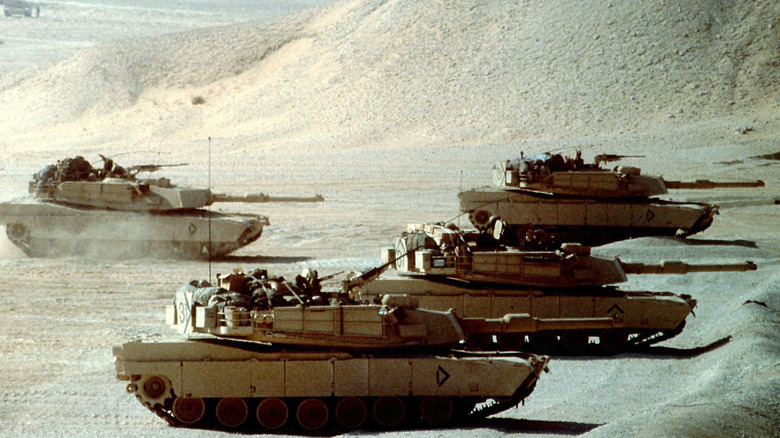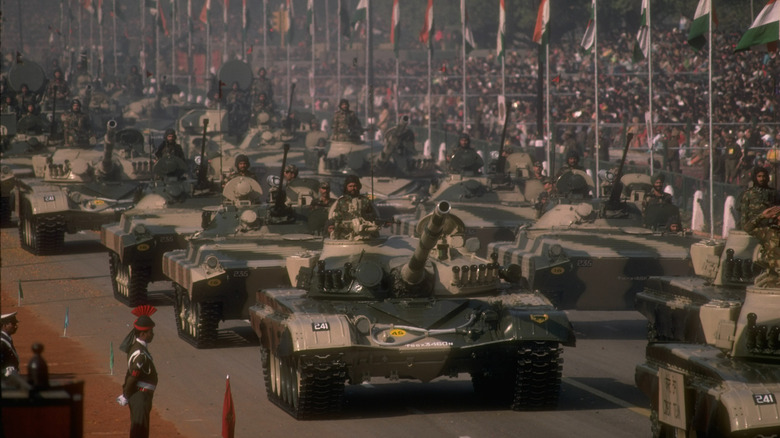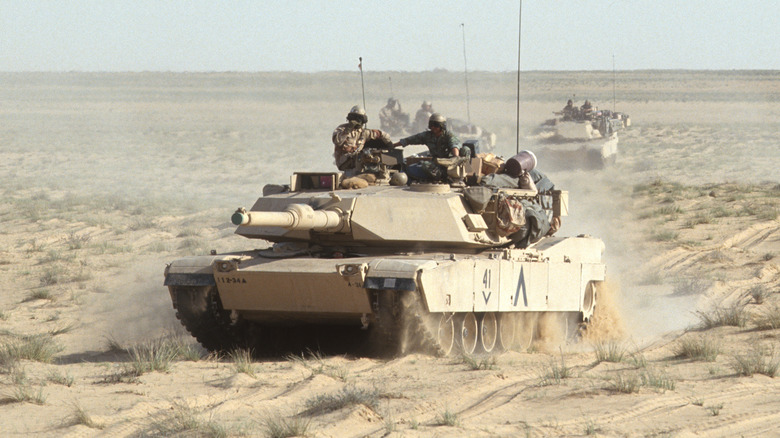T-72 Vs M1 Abrams: How Do These Battle Tanks Compare?
The American M1 Abrams main battle tank was designed in the late 1970s to combat possible threats coming out of the Soviet Union during the Cold War. As world events would have it, the Soviet Union formally collapsed in the late 1980s and early 1990s. Abram's first real combat usage was during the first Gulf War, where it fought Saddam Hussein's armored units that, coincidentally, mainly consisted of Soviet-made hardware. One such tank was the T-72.
The Russian T-72 series of main battle tanks was first produced in 1971 and is still in active service today, including the current war in Ukraine, where it is seeing heavy usage on both sides of the fight. According to the U.S. Army, over 20,000 T-72s of all variations have left the production line and been exported to dozens of countries, including many Western nations. Much like the Abrams, the T-72 has seen many upgrades over the decades.
T-72's size and power
The T-72 has a wide array of performance metrics, depending on what variation is being used and what country is deploying it. However, the basic measurements, powerplant, and armament are of roughly the same architecture across model designations.
It's powered by a V12 diesel engine paired with a seven-forward gear and one reverse gear transmission and is equipped with a 125-millimeter smoothbore cannon. The T-72's main hull is 22.8 feet long, 11.7 feet wide, and 7.3 feet tall. Add in the length of the gun, and it stretches to 31.2 feet long. Most variations weigh between 44 and 45 tons.
The base model, and the oldest variation of the tank's V12 diesel, outputs 780 horsepower, allowing it to reach speeds of 37.2 miles per hour. The upgraded T-72B3, which first saw service in Russia in 2010, ratchets up the power by a considerable degree. Its engine generates 1,130 horsepower, and it can reach a top speed of 43.4 miles per hour.
Soviet-era firepower
The main gun of the T-72 is a bit of an oddity, at least compared to other Western tanks. While an Abrams and Leopard II tank utilize a crew of four soldiers consisting of a tank commander, loader, driver, and gunner, the T-72 only has a three-person crew. The role of the loader has been eliminated with the use of an autoloader mechanism that automatically loads ammunition into the gun from a magazine of rounds located under the turret.
All variations of the T-72 can fire armor-piercing rounds, high-explosive shells, and high-explosive anti-tank rounds. Additionally, the T-72B3 can fire anti-tank missiles from the barrel of its gun. What the T-72 lacks in modernity, it makes up for in versatility.
The tank commander also has access to an NSV 12.7-millimeter heavy machine gun mounted on top of the turret, as well as a 7.62-millimeter PKT machine gun mounted in the turret's coaxial weapons system.
The T-72 meets its match
Uncle Sam's answer to the T-72 was the M1 Abrams. Its main armament of the upgraded 73.6-ton M1A2 consists of a 120-millimeter smoothbore cannon that can fire a variety of ammunition, including high-explosive anti-tank (HEAT) rounds to ranges exceeding 8,200 feet, although the actual range is classified. The Abrams' main party trick is its AGT-1500 turbine engine that can run on a variety of fuels, including diesel and kerosene, making it incredibly versatile. It can reach a top speed of 41 miles per hour flat-out.
During the aforementioned battle with T-72s during the first Gulf War, M1A1 Abrams tanks bested the Soviet pieces of armor at every single engagement. As reported by Defense and Security Monitor, during the armored vehicle slugfest that was the Battle of 73 Easting in February of 1991, the United States and Coalition forces didn't see a single Abrams fall in combat while simultaneously defeating 160 tanks, many of which were T-72s.
The T-72 reportedly couldn't even get within firing range of Coalition tanks before getting knocked out of commission. When a T-72 did manage to score a hit, the Abrams' depleted uranium armor was often able to shrug it off for the most part.
T-72 combat history
It's also worth taking a look at the combat history of the T-72. Throughout the Iran-Iraq war, which lasted from 1980 to 1989, T-72Ms (the designation for export models), under the flag of Saddam Hussein's Iraq, made short work of Iran's Chieftain and older M60 tanks. The British-engineered Chieftain entered service in the 1960s, and the American M60 hit the battlefields in 1959. It wasn't exactly a symmetrical engagement.
Like another widely proliferated Soviet armament, the AK-47, the T-72 has shown up in nearly every major battlefield, terrorist insurgency, civil war, or border dispute since it was first produced. With over 20,000 leaving the factories, it likely won't retire from active use for decades to come. Outdated or not, the T-72 isn't going away anytime soon. Whenever a budding democracy, rebel group, terrorist organization, dictatorship, or anyone else needs cheap and plentiful firepower, T-72s are likely the first items on their list.
Showing their age in the 21st century
In widely documented engagements like those that happened in Desert Storm, the T-72 was dominated in every single fight against the Abrams. It wasn't even a contest. Any future engagement between older versions of the T-72 and Abrams would likely end quickly. Early variants of the tank still see active combat in theaters like Africa and even in Ukraine. However, data is lacking on how new versions like the T-72B3 would fare against the M1A1 Abrams utilized by Ukrainian forces or, in the event of a wider-scale conflict, the M1A2 deployed by U.S. or NATO armies.
The T-72 has the advantage of sheer numbers, which is a strategy in its own right. However, the Abrams has the upper hand in not only historical engagements but also sheer weight, armor, firepower, adaptability of its turbine engine, and general combat aptitude. In any one-on-one engagement, the Abrams would quickly emerge the victor. On a 21st-century battlefield, both tanks are showing their age, but the T-72 is almost ancient comparatively.
